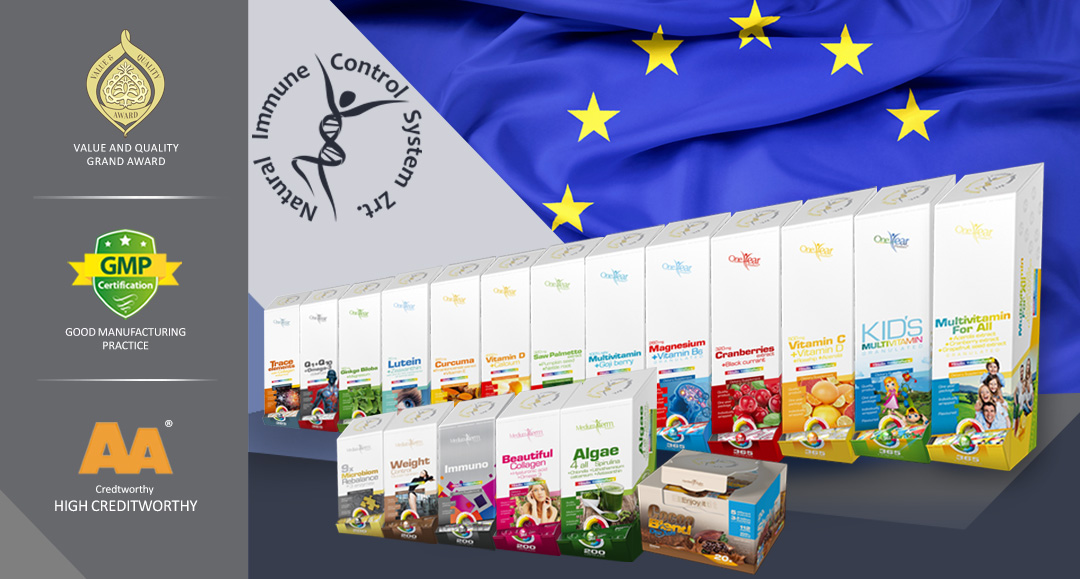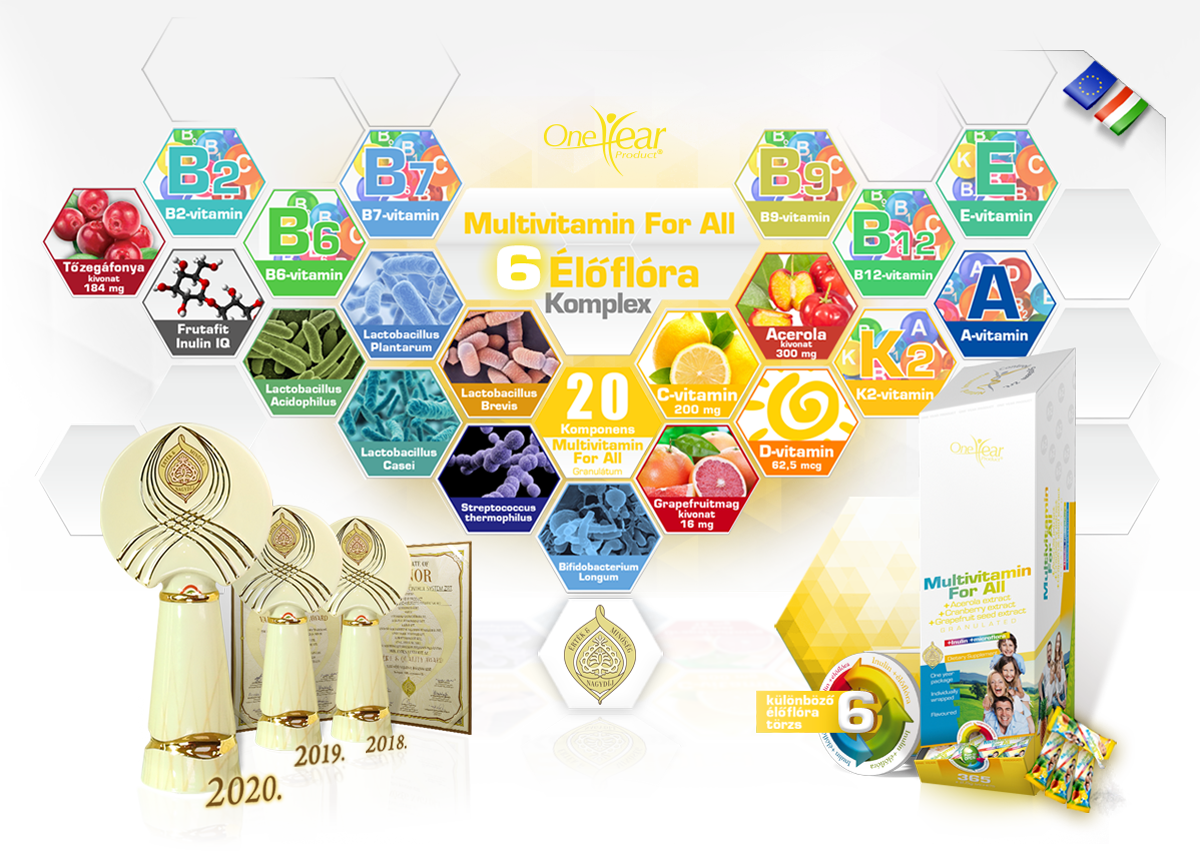|




|
Az itt látott étrend-kiegészítő megkapta az Érték és Minőség Nagydíjat.
Ezzel együtt már 23 termékünk érdemelte ki ezt a megtisztelő védjegyet, amely garancia
a minőségre valamint arra, hogy a lehető legjobb étrend-kiegészítőt használja egészsége
megőrzése érdekében.
|

|
|
Természetben előfordulva az acerola
|
|
Az acerola vagy más néven barbadoszi cseresznye akár öt méter magasra is megnő, lombhullató fa, amely nagy mennyiségű, 1-2 cm átmérőjű, piros gyümölcsöt terem. A gyümölcsök puhák, lédúsak, kellemes zamatúak. A acerola fa vadon nő, de Közép-Amerikában, Dél-Amerika északi vidékein, Brazíliában és Jamaicában is termesztik. A gyümölcs értékét elsősorban az adja, hogy jelentős mennyiségben tartalmaz C-vitamint. Ez az érés során csökken, ezért a kereskedelmi forgalomba hozandó gyümölcsöt még zöld állapotában szüretelik le.

|
|
Természetben előfordulva a tőzegáfonya
|
|
A tőzegáfonya egy Észak-Amerikában őshonos növény gyümölcse. Sötétpiros bogyói egész télen át díszítenek. A tőzegáfonya azonos növénycsaládba tartozik a vörös áfonyával és a fekete áfonyával.
Az áfonyát jellegzetes illatáért, frissítő ízéért már sokkal előbb fogyasztották minthogy gondoltak volna jótékony hatására. Feltehetőleg 1621-ben a zarándokok hálaadó ünnepen fogyasztották először az áfonyát, de az áfonyaszósz csak a polgárháború után vált nemzeti tradícióvá. Ulysses S. Grant kapitány az áfonyaszószt a hálaadás fontos részének tartotta. A Petersburg elleni csata alatt, 1864-ben elrendelte, hogy az Unió csapatainak áfonyát adjanak. A katonák a számukra eddig ismeretlen gyümölcsöt megszerették és fogyasztása szokássá vált. A telepesek nem tudtak az áfonya magas C-vitamin tartalmáról, de az angliai tengerészek között népszerűvé vált, mert akik ezt fogyasztották azoknál nem alakult ki skorbut. A XXI. század kezdetétől a tőzegáfonya használata egyre inkább elterjedt, és az elmúlt években igen népszerűvé vált. Az áfonyák bogyóját nyersen, szárítva, lekvárként, lisztté őrölve és mártásként fogyasztják.
A grapefruit (magyaros írásmód szerint grépfrút) vagy másnéven citrancs, a citrusfélék legfiatalabb tagja. A húsa rózsaszín és piros lehet. Természetben előfordulva magas a C-vitamin tartalma, illetve más vitaminokat, bioflavonoidokat tartalmaz. Íze savanykásan keserű. A kivonat a gyümölcs magjából és húsából készül.
A C-vitamin talán a legismertebb vitamin. A vízben oldódó vitaminok csoportjába sorolható cukorszármazék. A legtöbb állat szintetizálni tudja a saját vitaminszükségletét, ezzel szemben az embernek az étrendi forrásokra kell szorítkoznia. A C-vitamin csak igen kis mennyiségben fordul elő az állati eredetű tápanyagokban, a zöld növények, gyümölcsök fedezik a szükséglet döntő részét. Egyes növények különösen nagy mennyiséget tartalmaznak, például a csipkebogyó és egyes paprikafajok száraz súlyának 1-2 %-a C-vitamin. Tiszta állapotban mellékveséből Szent-Györgyi Albert izolálta elsőként 1928-ban, később 1931-ben citromléből és paradicsompaprikából. Ez volt az a felfedezés, melyet 1937-ben orvosi Nobel díjjal jutalmaztak.
Legfőbb természetes forrásai
A citrusfélék gyümölcsei, a bogyós termések, a zöld és leveles főzelékfélék, a paradicsom, a paprika.
|
|
Miért fontos a C-vitamin?
|
|
A C-vitamin hozzájárul a normál energiatermelő anyagcsere-folyamatokhoz, a normál pszichológiai funkció fenntartásához, az idegrendszer és az immunrendszer normál működéséhez. A normál kollagénképződéshez is hozzájárul a C-vitamin, ezen keresztül a bőr, az erek, a porcok, a csontozat, a fogak és a fogíny normál állapotának fenntartásához. Segít a fáradtság és kifáradás csökkentésében, hozzájárul az E-vitamin redukált formájának regenerálásához, illetve fokozza a vas felszívódását. Hozzájárul a sejtek oxidatív stresszel szembeni védelméhez, illetve az immunrendszer normál működéséhez intenzív testmozgás alatt vagy azt követően.
Zsíroldékony vegyület, amely a májban, a zsírszövetekben, a szívben, az izmokban, a vérben, a mellékvesékben és az agyalapi mirigyben raktározódik. Az E-vitamint a XX. század 20-30-as évei közt, a növényi olajok tanulmányozására irányuló kísérletek folytatása közben fedezték fel, majd izolálták, azonban csak a hetvenes években jöttek rá, hogy az ember számára létfontosságú anyagot fedeztek fel. Ellentétben a többi zsíroldékony vitaminnal, az E-vitamin, akárcsak a B-vitaminok vagy a C-vitamin, aránylag rövid ideig marad a szervezetben.
Legfőbb természetes forrásai
Búzacsíra, szójabab, növényi olajok, brokkoli, kelbimbó, spenót, teljes gabonamagvak, tojás.
|
|
Miért fontos az E-vitamin?
|
|
Hozzájárul a sejtek oxidatív stresszel szembeni védelméhez.
A K-vitamin a zsírban oldódó vitaminok közé tartozik. A K2-vitamin természetes formában elsősorban baktériumos erjesztéssel készülő élelmiszerekben, például az érett sajtokban található meg. Továbbá állati eredetű élelmiszerekben fordul elő, mint például libamáj, libacomb és csirkemáj. A K-vitamin részt vesz a normál véralvadásban és a normál csontozat fenntartásában.
Zsírban oldódó vitaminok csoportjába sorolható. A D3-vitamin a máj által előállított dehidrokoleszterinből a bőrben napfény hatására képződik. A D-vitaminnak van egy jellegzetessége: kialakulásához a bőrünket érő napsugárzásra van szükség, az ultraibolya sugarak egyikének különösen megvan az a képessége, hogy a bőrön belüli szteroidokat D-vitaminná alakítsa. A vesék és a máj teszik teljessé az ultraibolya sugárzás pozitív hatását és adják meg a lehetőséget a D-vitamin számára, hogy kifejthesse tevékenységét és átalakulhasson aktív formájába. Sokan inkább hormonnak tekintik a D-vitamint, mint valóságos vitaminnak. Azon anyagok egyikének, melyet a belső elválasztású mirigyek állítanak elő.
Legfőbb természetes forrásai
Halolaj, szardínia, hering, tonhal, lazac, tej és tejtermékek.
|
|
Miért fontos a D-vitamin?
|
|
A D-vitamin hozzájárul a vér normál kalciumszintjének fenntartásához, a kalcium és a foszfor normál felszívódásához, hasznosulásához. (A foszfor részt vesz a normál csontozat fenntartásában.) Szerepet játszik a sejtosztódásban, hozzájárul az egészséges izomfunkció, csontozat, a normál fogazat fenntartásához, illetve az immunrendszer normál működéséhez.
Az A-vitamin zsírban oldódó vitamin. Ahhoz, hogy az emésztőcsatornából felszívódjon, zsírokra és ásványi anyagokra van szükség. Kétféle formában fordul elő az egyik az A-elővitamin, a másik az A-provitamin, amit karotinként ismerünk.
Legfőbb természetes forrásai
Tej, tojás, sárgarépa, sárgadinnye, sárgabarack, sütőtök, spenót és az állati belsőségek (máj, vese, szív).
|
|
Miért fontos az A-vitamin?
|
|
Hozzájárul a nyálkahártyák, a bőr normál állapotának fenntartásához. Részt vesz a normál vasanyagcserében, szerepet játszik a sejtek differenciálódásában. Hozzájárul a normál látás fenntartásához, és az immunrendszer normál működéséhez.
Részt vesz a normál energiatermelő anyagcsere-folyamatokban. Hozzájárul a normál látás, a vörösvérsejtek, a bőr és a nyálkahártyák normál állapotának fenntartásához, az idegrendszer normál működéséhez. A B2-vitamin hozzájárul a fáradtság és kifáradás csökkentéséhez, és a normál vasanyagcseréhez, illetve a sejtek oxidatív stresszel szembeni védelméhez.
A B6-vitamin - más néven piridoxin - egy vegyületcsoport, amelynek tagjai rokon szerkezetűek és együtt hatnak. A XX. század harmincas éveinek végén öt egymástól független laboratóriumban lett izolálva. Vízoldékony vitamin, szervezetünk az anyagcsere során nem tárolja, az emésztés után 8 órán belül kiürül.
Legfőbb természetes forrásai
Búzakorpa, búzacsíra, sörélesztő, mák, káposzta, tej, tojás, marhahús.
Érdekesség
A terhesség idején jelentkező hányinger elleni gyógyszerek közül sok B6-vitamint tartalmaz.
|
|
Miért fontos a B6-vitamin?
|
|
Hozzájárul a normál pszichológiai funkció fenntartásához, az idegrendszer normál működéséhez, illetve a fáradtság és kifáradás csökkentéséhez. Részt vesz a normál energiatermelő anyagcsere-folyamatokban, a normál fehérje- és glikogén-anyagcserében és a normál cisztein-anyagcserében. A B6-vitamin hozzájárul az immunrendszer normál működéséhez, a hormonális aktivitás szabályozásához, a normál vörösvérsejt-képződéshez és a normál homocisztein-anyagcseréhez.
Hozzájárul az idegrendszer normál működéséhez, a normál pszichológiai funkció fenntartásához, a fáradtság és a kifáradás csökkentéséhez. Részt vesz a normál energiatermelő anyagcsere-folyamatokban, szerepet játszik a sejtosztódásban. A B12-vitamin hozzájárul az immunrendszer normál működéséhez, a normál vörösvérsejt-képződéshez és a normál homocisztein-anyagcseréhez.
A B9-vitamin vagy más néven folsav vízben oldódó vegyület, amely valójában nem egyetlen, hanem több hasonló felépítésű és hatású pteridin-származék. A folsav felfedezéséhez dr. Lucy Wills anémiás embereken élesztővel végzett kísérletei vezettek az 1930-as években.
Legfőbb természetes forrásai
A leveles zöldségek (kelbimbó, brokkoli, saláta, paraj), fekete szemű bab, máj, élesztő, földimogyoró, dió.
Hozzájárul az idegrendszer normál működéséhez, a normál pszichológiai funkció fenntartásához, a nyálkahártyák, a bőr és a haj normál állapotának fenntartásához. Részt vesz a normál energiatermelő anyagcsere-folyamatokban, illetve a makrotápanyagok normál anyagcseréjében.


Ez a One Year Product termék hatféle élőflórát tartalmaz emelt csíraszámban, továbbá a hatékonyságot növelő Inulint.
Inulin és élőflóra
Az élőflórát olyan jótékony, élő mikroorganizmusok alkotják, melyek a tápcsatornában a savas közeget is túlélve segítik a bélflóra egészséges egyensúlyának fenntartását. Termékeink magas csíraszámban tartalmaznak több élőflórát és a szaporodásukat elősegítő Inulint. A Probiotikum más néven élőflóra kifejezés görög eredetű, jelentése: az életért. A mai értelemben R. B. Parker alkalmazta először a probiotikum kifejezést 1974-ben, mint azokat az organizmusokat és anyagokat, amelyek a bélrendszer mikroba-egyensúlyáért felelősek. A probiotikumok jellemzői, hogy emberi eredetűek, nem kórokozók, ellenállnak a gyomorsav, az epe, valamint a nyál, a hasnyálmirigy és a bélnedvek emésztő enzimei hatásának. Az élelmiszerek szavatossági idejének tartalma alatt és a technológiai folyamatok során megőrzik ellenállóképességüket. Ezen kívül a probiotikumok képesek a nyálkahártyák sejtjeihez tapadni, a potenciális kórokozók ellen antimikrobás hatást fejtenek ki, csökkentik a kórokozó mikrobák megtapadását a nyálkahártya felszínén. A probiotikumok legnagyobb részben tejsavbaktériumok és bifidobaktériumok. A legismertebb probiotikus tejsavbaktérium-törzsek többsége a Lactobacillus, kisebb része a Streptococcus nemzetséghez tartozik. Prebiotikumoknak nevezzük azokat a természetes tápanyagokat, amelyek jellemzően a probiotikumok kizárólagos tápanyagai, ezért elősegítik azok elszaporodását és túlsúlyba kerülését. A szájüregben, illetve a gyomor-bélcsatornában az emésztőenzimek nem bontják le a prebiotikumokat, így emésztetlenül juthatnak a vastagbélbe. A prebiotikumok diétás rostok, de vízben oldhatók, ezért a diétás rostok közül is a legkiválóbbak. Élelmi rost funkciójuk mellett igazi hasznosságuk abban rejlik, hogy a probiotikumok kizárólagos táplálékai. Mivel a vastagbélben már kevés az emészthető táplálék, vagyis ott relatív táplálékhiány van, az elfogyasztott prebiotikumok lehetőséget kínálnak a humánbarát bélbaktériumok elszaporodására. Természetes állapotukban sok élelmiszerben előfordulnak, pl: csicsóka, cikóriagyökér, vöröshagyma, fokhagyma, póréhagyma, articsóka, teljes értékű gabonamagvak, búza, banán, len, spenót, káposztafélék, mangold, mustárfélék, bogyós gyümölcsök, hüvelyesek, tej és az érett sajtok többsége. A prebiotikumok egyik fajtája az Inulinok, tulajdonképpen egy diétás rost, mely emésztetlenül jut el a vastagbélbe, fokozzák a probiotikumok szaporodását, túlsúlyba kerülésüket. Szerepük: emésztés, bélflóra egyensúlya
A szervezetünk legnagyobb felszínnel rendelkező, mintegy 7-9 méter hosszúságú bélrendszerünkön keresztül áll kapcsolatban a külvilággal. Így potenciális támadási helyként szolgál a kórokozók és a toxikus anyagok számára. A bélben normális körülmények között mintegy 200-400 baktériumtörzs található. A magzati életben a jótékony baktériumok 95-98%-ban vannak túlsúlyban. Az egészséges bélflóra védelmet biztosít számos kórokozóval szemben, biztosítja a bélnyálkahártya épségét és segíti a szervezet számára szükséges tápanyagok felszívódását. Számos, a szervezet számára nélkülözhetetlen vitamint termelnek. Ha az emésztőrendszer védelmi mechanizmusai gyengülnek, az többek között felszívódási folyamatok zavarát okozhatja. A probiotikumok ahhoz, hogy képesek legyenek környezetükre hatást gyakorolni, a nagyszámú jelenlét alapfeltétel, mely a bélfolyadékban grammonként legalább 108 c.f.u. organizmust jelent. | Mit jelent a c.f.u. kifejezés? c.f.u.: kolóniaképző egység milliliterenként, az életképes mikroorganizmusok száma (csíraszám). A készítményekben általában ilyen egységben adják meg a baktériumok mennyiségét. Az Inulint azonban mg-ban határozzák meg. Megfelelő dózisnak a minimum 109 c.f.u. az elfogadott. | |
| Milyen a hatékony élőflórás készítmény? - | A probiotikumok szaporodását a prebiotikumok elősegítik, ezért tartalmazzon a készítmény Inulint vagy frukto-oligoszacharidákat. | | - | Ellenállnak a gyomorsav, az epe, illetve az emésztőenzimek hatásainak, így élve el tudnak jutni a hasznos baktériumok a vastagbélbe, ahol képesek elszaporodni és megtapadni. Alapvető kritérium, hogy a baktériumok megtartsák életképességüket a gyomor-bélrendszerben történő áthaladásuk során. | | - | A jó élőflórás készítmények minimum 5-6 törzset tartalmaznak, hiszen a bélbaktériumok sokrétű multikultúráját kívánjuk pótolni. | | - | Szavatossági idő alatt és a technológiai folyamatok során megőrzik ellenálló képességüket. | | - | Megfelelő mennyiségű csíraszámot tartalmaz, szakemberek által javasolt
minimum 108 vagy 109 telepképző egység. |
| |
|